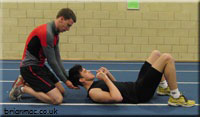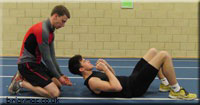

Curl-Up Test
Testing and measurement are the means of collecting information upon which subsequent performance evaluations and decisions are made. In the analysis, we need to consider the factors influencing the results.
Objective
The Curl-Up Test's objective is to assess the endurance of the athlete's abdominal muscles.
Required Resources
To conduct this test, you will require:
- Flat non-slip surface
- Mat
- Metronome
- Assistant
How to conduct the test
This test requires the athlete to complete as many curl-ups as possible at a rate of 20/minute.
|
 Figure 1  Figure 2 |
Analysis
The test result is analysed by comparing it with the athlete's previous results for this test. It is expected that the analysis would indicate an improvement in the athlete's core strength with appropriate training between each test.
Target Group
This test is suitable for active individuals but not for those where the test would be contraindicated.
Reliability
Test reliability refers to how a test is consistent and stable in measuring its intended measure. Reliability will depend upon how strict the test is conducted and the individual's level of motivation to perform the test. The following link provides various factors influencing the results and test reliability.
Validity
Test validity refers to the degree to which the test measures what it claims to measure and the extent to which inferences, conclusions, and decisions based on test scores are appropriate and meaningful. This test provides a means to monitor training on the athlete's physical development.
Advantages
- Minimal equipment required
- Simple to set up and conduct
- Can be conducted almost anywhere
Disadvantages
- Specialist equipment required - Metronome
- Assistant required to administer the test
References
- McARDLE, W.D. et al. (2000) Training muscles to become stronger. In: McARDLE, W.D. et al., 2nd ed. Essentials of Exercise Physiology, USA: Lippincott Williams and Wilkins, p. 417
Page Reference
If you quote information from this page in your work, then the reference for this page is:
- MACKENZIE, B. (2005) Curl-Up Test [WWW] Available from: https://www.brianmac.co.uk/curluptst.htm [Accessed